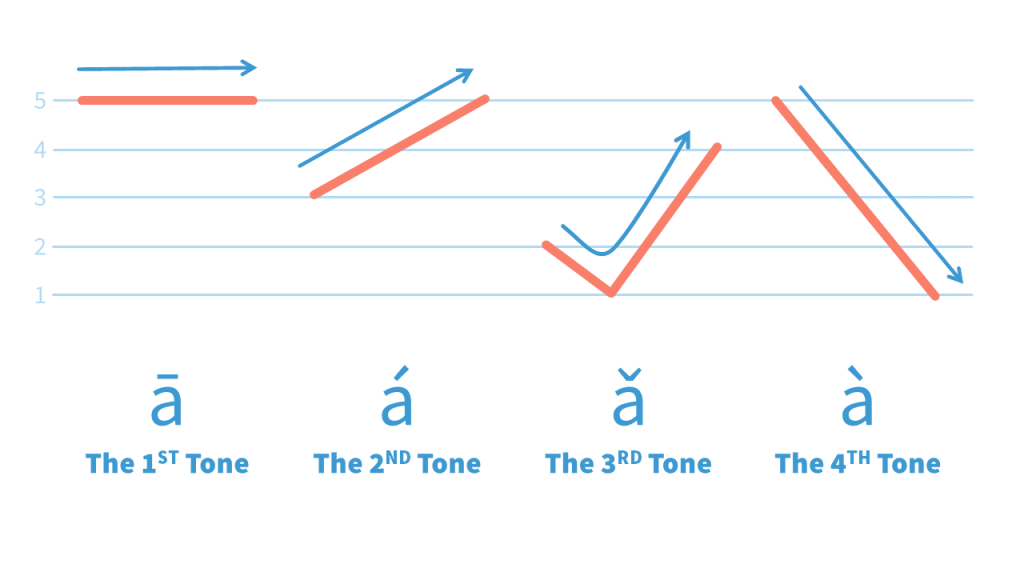Tone Lesson 1- How To Pronounce The Four Mandarin Chinese Tones

THE FOUR MANDARIN CHINESE TONES
In this Chinese Tones lesson, you will learn how to write Chinese Tone marks and the pronunciation techniques of the four Mandarin Chinese Tones. We will be doing a lot of effective Chinese Tone practice with the instructional video. Starting from here, you will find yourself pronouncing Mandarin Chinese Tones much more comfortably.
How to Master Mandarin Chinese Tones
Our very first step is to be able to pronounce each Tone correctly individually. And then we'll try to put them together in Tone Pairs, Tone Groups and sentences for more intensive Chinese Tone practice.
Individual Tone ➜ Tone Pairs ➜ Tone Groups ➜ Sentences
Also, as we've mentioned in our Perfect Pronunciation: Pinyin Drills Course, when you first start to learn a language, don't be afraid to sound "exaggerated" or "fake" while doing pronunciation practice. Because only when you can pronounce them the exact and 100% correct way, then can you start to speak with the Tone modified or faster, more relaxed and more "natural".
Exact, Standard, or "Exaggerated" Pronunciation ➜ Modified, Faster, or "Natural" Pronunciation
How to Write Chinese Tone Marks

In the video of this Chinese Tones lesson, you will see the way to write Chinese Tone marks. The way you write them represent the same techniques that you pronounce them. The First Tone: starts high and maintain the same high pitch the whole process. The Second Tone: starts in the middle, semi high, and goes up. The Third Tone: starts in the middle, drops down, and goes back up again. The Fourth Tone: starts high, and then quickly goes down. And we put the mark on the main vowel of the Final - whichever comes first in this list: a o e i u ü. And if the Final is iu or ui, the mark falls on the last letter.
The 5-Line Chinese Tone Graph
The 5-line Chinese Tone Graph is the proven best way for Chinese Tone practice. This is not how to write Chinese Tone marks. Instead, we use the 5 lines to
represent the pitch of our voice, 5 is the highest and 1 is the lowest. The graph can help visualize each tone so it is easier for us to make adjustments accordingly.
But please pay attention that the "5" or "1" here is not a fixed pitch, because everyone has different voice range. Some people higher and some people lower. While practicing along with the video of each Chinese Tones lesson, please pay attention to the 5-Line Chinese Tone Graph. Watch how the pitch is like for each Tone. It works amazingly for pronunciation.

Lengths of Mandarin Chinese Tones
With the same syllable is pronounced in different Tones, some Tones lasts longer than the others. Generally, the Third Tone lasts the longest, the Fourth Tone is the shortest. The First Tone and the Second Tone are not too long and not to short.

Hi i love your website
i learn a lot of chinese
xiexie
Taniarosario,
Thank you for your good example. I saw that you had completed this quiz six times until you perfected it.
Now, I’m doing the same and my retention of the material has greatly improved!
Thank you,
Arizona Cowboy
This is very difficult for me! I really want to learn Mandarin. I seem to be very slow in differentiating the different tones. I am using a recorder to record both the instructors’ tones and my tones. Any recommendations, other than practice, practice, practice? Please help.
The tones can be tricky and difficult for both beginners and more advanced learners, but it’s something that gets easier with time. Like all things it just takes some time getting used to. So don’t worry,it may seem hard in the beginning, but I believe you will get it with practice!
Hi, first–is this area the sticky comments? second-what is best way to approach studying between the beginner lessons,pinyin,tones, characters–in terms of following the videos. thx
Please see our Learning Road Map for more information.
when typing pingin, how does one indicate the tones?
as an aside, i also am wondering about the question Miquel asked in summer 2019 about tips to pronounce e and v.
When typing Pinyin to input Chinese characters the tone is not marked. Only the syllable is spelled.
I have a low voice, my first tone is around a G2 in standard tuning lol
Can u help me with the “e” and “ü” tips to pronounce…? It´s a complicate for me! Thanks !!
I am in a second level beginners course in Mandarin and find your courses to be a strong and helpful supplement to the course I am taking. In fact, I find it more personal and detailed than the actual class. I especially struggle with the tones and am so glad that you have a way to practice that I can go back to time and time again. It is extremely helpful and the effort you have put into this program is very thourough. It’s like having my own tutor. Thank you so very much for taking the time to create such a program. 谢谢!
We’re very glad to hear you enjoy our courses! Thank you for the kind words, we wish you the best with your Chinese studies!
This is exceptionally well-made!
Thanks for leaving such a positive feedback on the Chinese Tone practice!
Bless you for providing such a thorough course! 🙂
Thanks a lot! I’m glad you like our Chinese Tones lessons!
I just want to say that hearing Chuck’s pronunciation is incredibly helpful. Nearly all teaching resources I find are spoken by women, making it difficult for me to gauge where my tones should be for my male voice, so thank you.
Thanks! We know that chinese tones are something people struggle with. I studied in China for 5 years and during that time I only had 3 male teachers. The first tone is very important and most students get their point of reference from a female who’s pitch is naturally an octave higher than theirs, which usually results in students having a high pitch voice when speaking Chinese.
Ah I had the same problem. Its a lot easier with Chuck for sure!